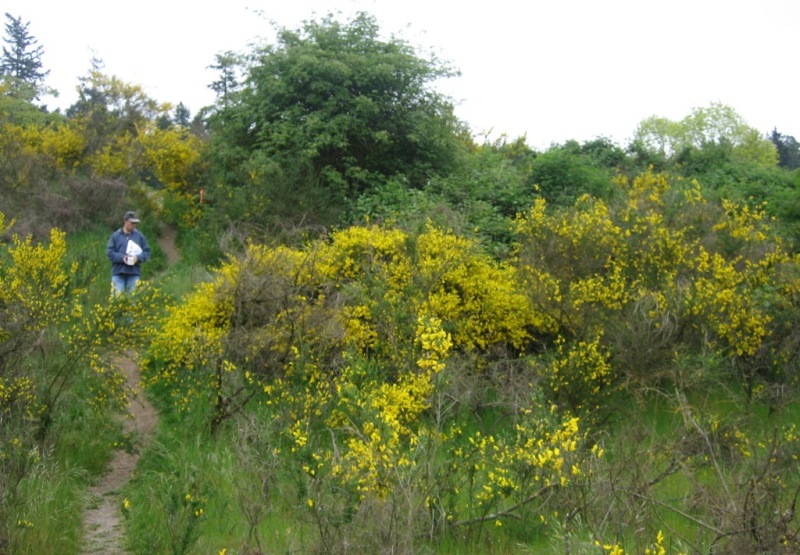Scotch broom identification and control
Cytisus scoparius

Scotch broom, a non-regulated Class B noxious weed, is an evergreen shrub that grows 6-10 feet tall and forms dense stands throughout King County, including in pastures, empty lots, and on roadsides. Leaves are small, short-lived, and simple or 3-parted. Branches are erect and angled, with prominent ridges. In March-June, produces bright yellow, pea-like flowers all along stems, followed by black, hard seedpods with hairy edges. Reproduces via seeds that can persist in soil up to 60 years. Prefers full sun, but tolerates shade.
History and impact
Legal status in King County, Washington
Public and private landowners are not generally required to control infestations of Scotch broom that occur on their property in King County, Washington. The one exception is on the WSDOT right-of-way of I-90 east of mile post 34 and on the WSDOT right-of-way of Highway 2 where it dips down into King County before crossing Stevens Pass, in order to reduce Scotch broom's spread to neighboring Kittitas and Chelan Counties.
Scotch broom is a Class B Noxious Weed in Washington, first listed in 1988. Because control is not generally required in King County, it is on the list of Non-Regulated Noxious Weeds in King County.
This species is also on the Washington quarantine list (known as the prohibited plants list) and it is prohibited to transport, buy, sell, offer for sale, or to distribute plants or plant parts, seeds in packets, blends or "wildflower mixes" of this species, into or within the state of Washington.
For more information on noxious weed regulations and definitions, see Noxious weed lists and laws.
Biology and morphology
Additional information on Scotch broom
- Scotch broom weed alert (603 KB Acrobat file)
- Scotch broom best management practices (383 KB Acrobat file)
- Washington State Noxious Weed Control Board (external link)
What to do if you find this plant in King County, Washington
Because Scotch broom is so widespread, property owners in King County are not required to control it and we are not generally tracking infestations. We can provide advice on how to control Scotch broom, but there is generally no legal requirement to do so. Many public agencies and conservation organizations are actively working to remove Scotch broom where they have the resources, and may have opportunities for you to volunteer. However,only remove Scotch broom where you have permission to work! For information on useful tools for removing woody plants like Scotch broom, see this post by Northwest Illinois Forestry Association. King County residents can borrow a Weed Wrench or other similar tools from the Noxious Weed Control Program. For more information, contact our office.
Scotch broom photos








Related information
Related agencies
Program offices are located at 201 S. Jackson St., Suite 600, Seattle, WA 98104. To contact staff, see the Noxious Weed Control Program Directory, send an email, or call 206-477-WEED (206-477-9333).

 Translate
Translate

